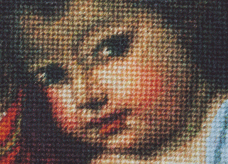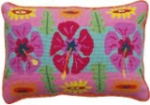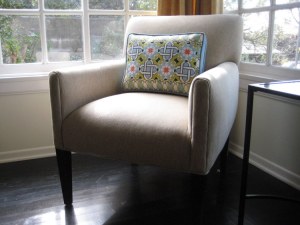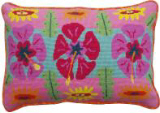What is the difference between a variegated and overdyed thread in needlepoint?
A variegated thread, which may also be called a semi-solid, has been factory-dyed varied tones of the same color. For example, if you look at a blue variegated thread, you will see the blue color goes from light to dark, over and over again, in even bands (e.g. three inches) along the thread. So there might be three inches of very light blue, followed by three inches of slightly darker blue, all the way up to a dark blue, and then these bands are repeated.
An overdyed thread is one that has been dyed over an existing color, and it is usually done by hand. This means the color variations are more random and unevenly spaced, and the colors need not be from the same group e.g. red may be over-dyed onto an orange thread. The colors that are overdyed could be contrasting or subtle.
Most fiber manufacturers produce a variegated and/overdyed selection. DMC, for example, has 18 variegated and 36 overdyed (called Color Variations) cottons.
 |
 |
| DMC Variegated Threads |
DMC Overdyed Thread
(Called Color Variations) |
Tips For Stitching With Variegated and Overdyed Threads
The thing you need to keep in mind when stitching with these threads is that if you stitch in a straight line they will form stripes, or bands. This can be an effect you want, or it can turn out to be an effect you don’t want.
If you are stitching a tree trunk, for example, a vertical “stripe” or bands of subtly changing color can give your tree an appropriately organic and realistic look. So a good use for a variegated or overdyed thread? Yes, absolutely, but only if you place the stitches in vertical columns; otherwise you will get horizontal bands and this could look odd.
Similarly with sea and sky. Who, outside of perhaps Arizona or California, ever sees an evenly blue sky? There are subtle color variations in most elements of nature and this is where overdyed and variegated threads can be used to their best effect. But you would want to stitch the sea or sky in horizontal lines (Continental stitch) and not basketweave, which will give you diagonal/oblique bands of color.
So, you need to pay attention to the direction you are laying down your stitches.
The other effect you can get with variegated and overdyed threads is a mottled or speckled effect which can also look very organic if you think about how you place your stitches. If you want your color variations to look random and speckled, then you need to place your stitches randomly. This might be a good way of stitching fur, or landscape features (grassy hills?). Place a stitch every 3 or 5 or 4 holes and then go back and fill in the spaces randomly. It will mean your canvas is a bit of a mess on the back (cue the sirens from the “needlepoint police”), but you will have a nice, subtly changing color variation on the front of your canvas.
Alternatively, you can “clump” the stitches together to get clumps of color on your canvas, which might look like tweed (clump in squares), or groves of trees on distant hills if you clump in roundish groups of stitches.
Not All Variegated Threads Are The Same
Try to match the variegated or overdyed thread to the area you are stitching. Some threads will have more subtle color changes than others. For example, most things in nature will be variegated within the same color family e.g. shades of green, and so a subtle variegated thread would be a good choice to get realistic shading in this instance. Other overdyes might have quite contrasting colors e.g. grey on white. This would look strange on something that is quite even in color in reality, but an object like a carpet or outdoor path might look effective stitched in a less-subtly contrasting thread.
Do you get the idea that you need to play around a bit with variegated and overdyed threads? Inspect how the color changes on the thread and decide how you will lay it on the canvas. Then wait and see what it looks like because it’s hard to know in advance. Hopefully you will like it; and certainly, with experience you will get a ‘feel’ for the effects of variegated threads.
A Note About Cross Stitch
If you are stitching a Victorian Cross Stitch in needlepoint then it is customary to complete both arms of the cross at once before moving on to the next stitch (as opposed to traditional cross stitch where you stitch a half cross along the row and then reverse back along that row to complete the top arm of the cross). This needlepoint method will give you a striped effect if you are using a variegated or overdyed thread, and if you do not want this effect then you are better served using the traditional cross stitch method whereby the half stitch placed over the top will be a more random shade to the one underneath and will give you a mottled effect.




 This one’s for me! If you picked up the cushion on my stitching chair (don’t worry, I never intend to), you would find a bird’s nest of thread snippets. So, don’t be like me, start an ort jar and put all your leftover threads into it.
This one’s for me! If you picked up the cushion on my stitching chair (don’t worry, I never intend to), you would find a bird’s nest of thread snippets. So, don’t be like me, start an ort jar and put all your leftover threads into it.






























